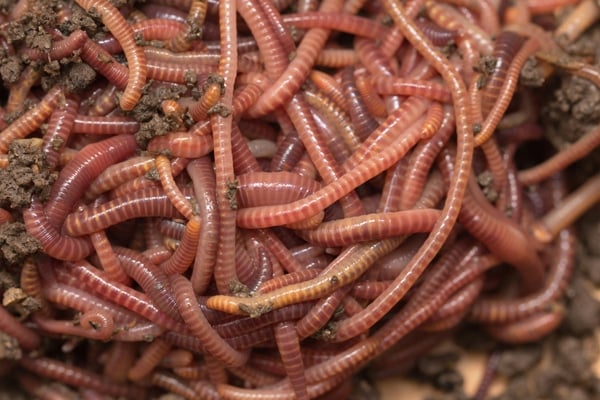Achieve a Greener Lawn with the Help of Red Wiggler Express Lawn Care Treatments
Achieve a Greener Lawn with the Help of Red Wiggler Express Lawn Care Treatments
Blog Article
How Red Wigglers Can Transform Your Composting Experience
The integration of red wigglers into composting methods supplies a transformative strategy to squander administration and soil enrichment. Comprehending the certain requirements and benefits linked with preserving a flourishing worm populace is critical for maximizing their possibility.
Advantages of Red Wigglers
Red wigglers, clinically referred to as Eisenia fetida, are a cornerstone of reliable composting systems because of their impressive capacity to break down natural issue successfully. These worms master transforming kitchen scraps, lawn waste, and other organic products right into nutrient-rich garden compost, typically referred to as worm castings. Lake Hickory Bait. This procedure not only lowers land fill waste however also adds to lasting gardening methods
One of the key benefits of red wigglers is their high recreation rate, enabling them to occupy a composting atmosphere quickly. This quick reproduction improves decomposition prices, resulting in faster compost production. In addition, red wigglers grow in a diverse variety of conditions, making them adaptable to numerous composting arrangements.

Setting Up Your Worm Bin
(Charlotte NC Worms For Sale)To produce a reliable worm bin for composting, careful focus must be offered to its design and setting. An optimal worm bin should be created of products that are durable yet permit for needed air movement, such as plastic or wood. The size of the bin can vary, but a quantity of about 1 square foot per pound of worms is a great beginning factor.
Ensure that the bin has drain holes to stop water buildup, which can bring about anaerobic problems detrimental to the worms. In addition, incorporating ventilation holes will certainly help preserve appropriate humidity degrees and oxygen circulation.
Next, it is important to supply bed linens for the worms, which can include shredded paper, cardboard, or coconut coir. This bed linens not just offers an environment for the worms however also aids in dampness retention.
Placement the worm bin in a place that maintains a temperature level variety of 55-77 ° F(13-25 ° C) to optimize worm task. Stay clear of placing the container in direct sunshine or extreme temperatures. By complying with these guidelines, you can produce a favorable setting for red wigglers, next improving the effectiveness of your composting procedure.
What to Feed Your Worms

(Charlotte NC Worms For Sale)Red wigglers specifically appreciate soft, wet foods like watermelon peels, cucumber peels, and banana peels. It is important to avoid feeding them citrus fruits, onions, and garlic, as these can be harmful to their well-being. Furthermore, cooked foods, milk products, and meat needs to be strictly prevented, as they can bring about smells and attract bugs.
Supplying a constant feeding timetable will certainly assist keep your worm populace growing while improving the general performance of your composting initiatives. By recognizing what to feed your worms, you lay the foundation for a successful and sustainable composting experience.
Keeping a Healthy And Balanced Environment
Producing a flourishing composting environment for red wigglers needs focus to their habitat, as it directly affects their wellness and efficiency. The suitable habitat needs to maintain a balanced moisture level, typically in between 60-70%. Excessive moisture can lead to anaerobic problems, while insufficient wetness may dehydrate the worms.

The bed linens product in the garden compost need to be diverse and shredded, incorporating materials like cardboard, newspaper, and coconut coir. This not just supplies a comfortable atmosphere but also works as a food source. Lake Hickory Bait. Frequently checking for smells or indications of pests can help recognize possible issues before they rise
Lastly, keeping a well balanced pH level, preferably in between 6 and 7, makes certain a helpful environment for red wigglers, fostering their capacity to process natural issue efficiently. By attending to these factors, you can create a lasting and productive composting ecological community.
Harvesting and Making Use Of Compost
Collecting compost from a worm container is a rewarding procedure that changes organic waste right into nutrient-rich material for gardens and plants. Once the composting cycle is full, commonly after 8-12 weeks, it's time to collect the vermicompost. The first step entails separating the red wigglers from the finished garden compost. This can be done utilizing methods such as the "light" technique, where worms are attracted to light and can be scooped far from the top layers, or by moving the compost to one side of the container and including fresh bed linens to the opposite, motivating the worms to migrate.
When the worms are gotten rid of, the continuing to be garden compost can be filtered to eliminate any kind of bigger fragments or undecomposed product. This rich compost can be applied straight to garden beds, mixed right into potting dirt, or used as a top clothing for potted plants.
Conclusion
Incorporating red wigglers into composting techniques substantially enhances the decay process and adds to the manufacturing of nutrient-rich vermicompost. Their adaptability to numerous atmospheres and high reproduction prices make sure a lasting population, which efficiently damages down raw material. The resulting worm spreadings improve dirt framework, fertility, and microbial activity, eventually advertising much healthier plant growth. Consequently, the combination of red wigglers right into composting not just maximizes waste management however also enriches yard ecosystems.
Report this page